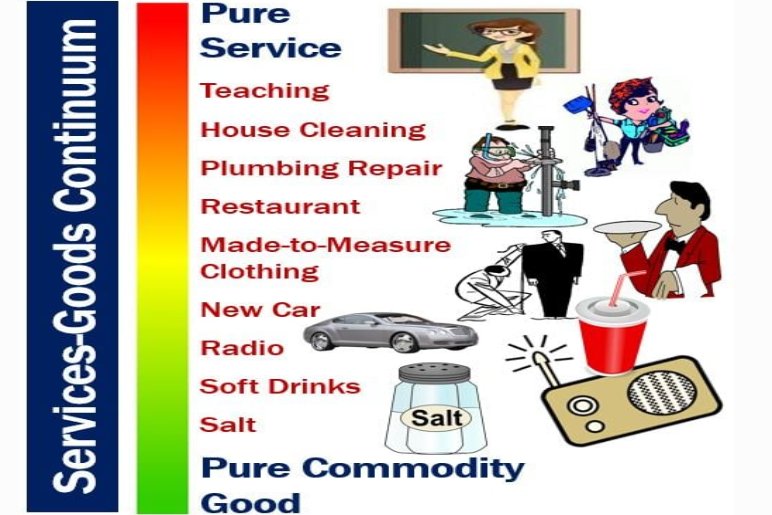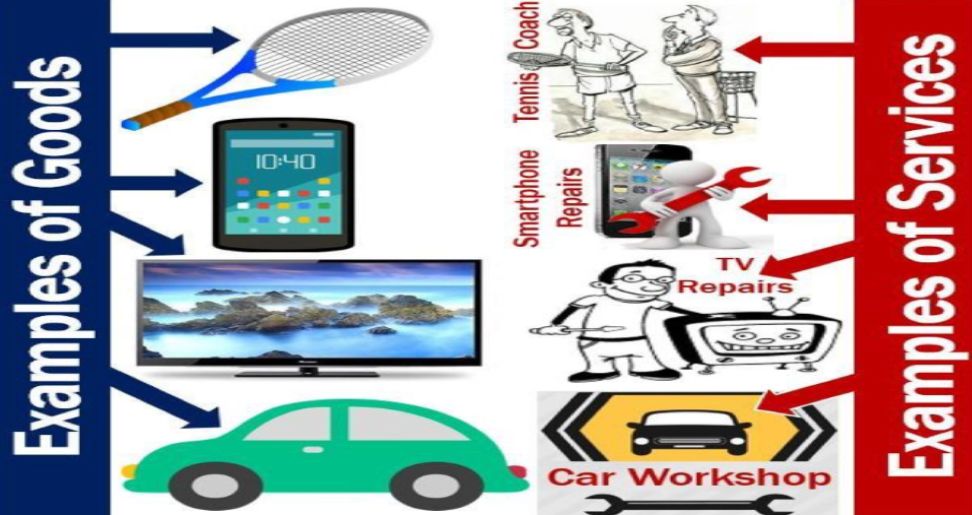In the realm of economics and business, the term “services” often stands in contrast to “goods.”
While goods are tangible products that can be seen, touched, and owned, services are intangible activities or processes that provide value to customers. This article delves into the nature of services, their characteristics, and their significance in the modern economy.
Defining Services

A service is essentially an action or performance that one party provides to another.
It is an intangible product that is consumed at the time of delivery. Unlike goods, services cannot be stored for later use. The value of a service lies in its ability to satisfy customer needs and desires.
For instance, a haircut, a medical consultation, or a financial advisory service are all examples of services.
These activities involve an interaction between the service provider and the customer, and the outcome is often an experience rather than a physical possession.
We can’t store services
Services are intangible assets, fundamentally different from physical goods.
Unlike products that can be manufactured, packaged, and stored in warehouses for later consumption, services are consumed at the moment of delivery. They require a simultaneous interaction between the provider and the consumer. While the outcomes or results of a service might be documented or digitized, the core service itself cannot be stored. This inherent characteristic distinguishes services from products and necessitates real-time delivery models, emphasizing the importance of efficient service management systems and responsive customer interactions.
Goods vs. services

Goods and services are the two fundamental components that drive economic activity.
While they both contribute to fulfilling human needs and wants, they possess distinct characteristics.
Goods
- Tangible: Goods have a physical form. They can be touched, seen, and stored.
- Ownership: Goods can be owned and transferred from one person to another.
- Production and Consumption: Goods are typically produced before they are consumed.
- Homogeneous: Goods can be standardized and mass-produced, ensuring consistency.
- Examples: Cars, electronics, food, clothing, furniture.
Services
- Intangible: Services are actions or activities performed for others. They cannot be touched or seen.
- Consumption and Production: Services are produced and consumed simultaneously.
- Heterogeneous: Services vary depending on the service provider and the customer’s needs.
- Inseparability: The service provider and the customer are often involved in the production process together.
- Perishability: Services cannot be stored for later consumption.
- Examples: Education, healthcare, transportation, consulting, entertainment.
The Five I’s of Services

The five I’s of services are a framework used to understand the unique characteristics of services that differentiate them from tangible products. These characteristics have significant implications for service marketing and management.
Intangibility
Unlike physical products, services cannot be seen, touched, tasted, smelled, or owned. This intangible nature makes it difficult for customers to evaluate a service before purchase, leading to perceived risk. To mitigate this, service providers often use tangible cues, such as physical facilities, employee appearance, or written materials, to create a perception of quality.
Inconsistency
Service quality can vary depending on the individual service provider, customer, and situation. This inconsistency is due to the human element involved in service delivery. To address this, service organizations focus on employee training, standardization of procedures, and quality control mechanisms.
Inseparability
In most cases, the service is produced and consumed simultaneously. The service provider and the customer interact during the service delivery process. This inseparability means that the quality of the service is influenced by both the service provider and the customer. Effective employee training and customer relationship management are crucial for delivering consistent service quality.
Inventory
Unlike physical products, services cannot be stored for later use. This is known as the perishability of services. Service capacity must be carefully managed to match demand, as unsold services are lost forever. Overbooking, flexible pricing, and demand forecasting are strategies used to manage service capacity.
Involvement
Customers often participate in the service creation process. Their satisfaction and behavior can significantly impact the service outcome. High levels of customer involvement can lead to increased service quality, but it also requires careful management to ensure customer satisfaction. Effective communication and customer empowerment are essential for successful customer involvement.
By understanding these five characteristics, service organizations can develop effective marketing and operational strategies to create value for customers and achieve competitive advantage.
“Service” as a Derivative of “Serve”

The word “service” is indeed a derivative of the verb “serve”. This linguistic relationship can be traced back to the evolution of language and word formation processes.
Understanding Derivation
To grasp this connection, it’s essential to understand the concept of derivation in linguistics. Derivation is the process of creating new words from existing ones by adding prefixes, suffixes, or changing the word’s internal structure.
The Journey of “Serve” to “Service”
Latin Roots: The verb “serve” originates from the Latin word “servire,” which means “to be a slave” or “to be subject to.” This implies a sense of duty, obedience, and providing assistance.
Noun Formation: Over time, languages evolved, and words adapted to new contexts. In this case, the Latin verb “servire” gave rise to the noun “servitium,” meaning “slavery” or “servitude.”
Transition to English: As Latin influenced the development of Romance languages and subsequently English, the concept of “servitium” evolved into the Old French word “service.” This word carried the connotation of performing duties or providing assistance.
Modern Usage: In modern English, “service” has broadened its meaning to encompass a wide range of actions, from providing assistance to offering professional help. However, the core idea of performing a function for others remains connected to its root, the verb “serve.”
Examples of Derivation

To further illustrate the concept of derivation, consider these examples:
- Serve (Verb)
Serve as the cornerstone of hospitality, restaurants must diligently serve patrons with impeccable food and service. To truly serve a community, one must go beyond fulfilling needs; they must serve with compassion and empathy.
- Service (Noun)
Service is an intangible asset that businesses offer to customers in exchange for payment. It involves performing tasks or fulfilling needs without transferring ownership of a physical product. A strong service orientation often leads to customer satisfaction and loyalty, driving business growth.
- Services (Noun, plural)
Services offered by modern businesses encompass a vast spectrum. From customer support and technical assistance to financial consulting and digital marketing, the range of specialized offerings is continually expanding. These services often require skilled professionals to deliver value and satisfaction to clients, contributing significantly to overall business growth and success.
- Servant (Noun)
A servant is a person employed to perform duties for another, typically in a household or establishment.
- Servitude (Noun)
Servitude is the oppressive state of being subject to another’s control, a condition marked by a lack of personal freedom and autonomy. It can manifest as forced labor, bondage, or even psychological dependency.
- Server (Noun)
A server is a computer program or device that manages and fulfills network requests. It operates as a central repository of data and applications, providing resources and services to clients over a network. Servers can range from personal computers to specialized hardware, each designed to handle specific workloads and user demands.
- Serviceable (Adjective)
The old, leather armchair in the library corner was certainly serviceable, providing adequate support for weary readers. Though worn and faded, it held its shape and offered a comfortable perch for those seeking solace in the written word. Its serviceability was undeniable, even if its aesthetic appeal had diminished over the years.
Read More:
- OLA Electric IPO: A Guide to Dates, Pricing, and How to Invest
- MarkkyStreams: Allure of Free Sports vs. The Hidden Dangers
- Diversified Commercial Services: A Spectrum of Opportunities
Featured Image Source: https://tinyurl.com/7aahuhw7

